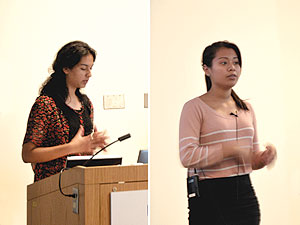
Somerville teens Fatima Khan (left) and Jasmine Ngan (right) presented results of their independent studies at Tufts University School of Medicine. – Photos courtesy of Tufts
Two young Somerville residents participated in an event at Tufts University School of Medicine celebrating their achievements as part of Tufts’ program to encourage students from diverse backgrounds to pursue careers in medicine and science. Somerville residents Fatima Khan, 16, and Jasmine Ngan, 16 presented the findings of their independent studies to family, friends, and the Tufts community.
Khan’s presentation was on “Abdominal Aortic Aneurysms.” She spent five weeks studying Abdominal Aortic Aneurysms (AAA) in mouse models. An AAA is a localized dilation of the large blood vessel that supplies the legs. This condition most commonly occurs in men over the age of 65 who smoke. An AAA can be a life-threatening condition, because it is often without symptoms and can rupture spontaneously. When the abdominal aorta ruptures, a large volume of blood spills into the abdomen and can cause death if not treated urgently. Under her mentor’s direction, Khan was studying whether or not statins can reduce the formation of AAA in mice. Statins are drugs that are prescribed to treat high cholesterol. Eventually, this research could be extended to humans.
Ngan’s presentation was on “The Effects of Storage Conditions on Bloodspot Amino Acids.” She spent her summer studying the effects of storage conditions on bloodspot amino acids. Amino acids are the building blocks of proteins. Most of the 22 amino acids can be made within the human body. Those that cannot must be obtained through the diet. Some individuals are born without the ability to synthesize particular amino acids. As a result, they are deficient and must take regular dietary supplements. In order to assess the effectiveness of the dietary supplements, the patient’s blood must be tested regularly using an at-home collection kit. The patient pricks his/her finger and touches it to a piece of paper, which is then sent to a lab to be analyzed. Ngan was studying how the storage conditions of the paper post-test, such as light exposure and room temperature, may affect the amount of amino acid that is detected.















Reader Comments